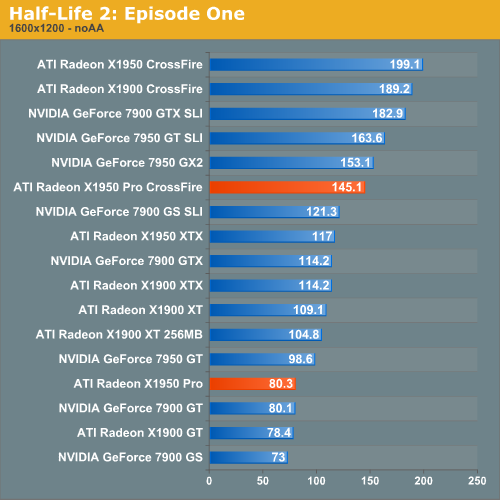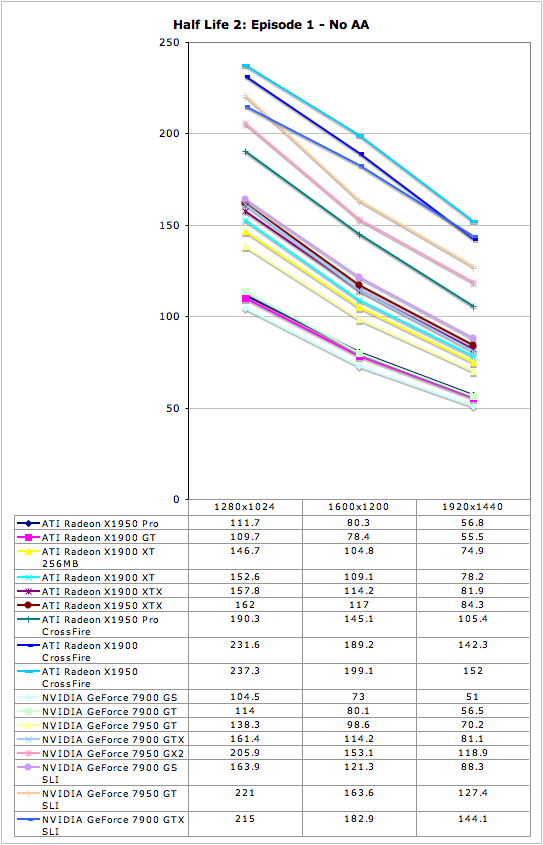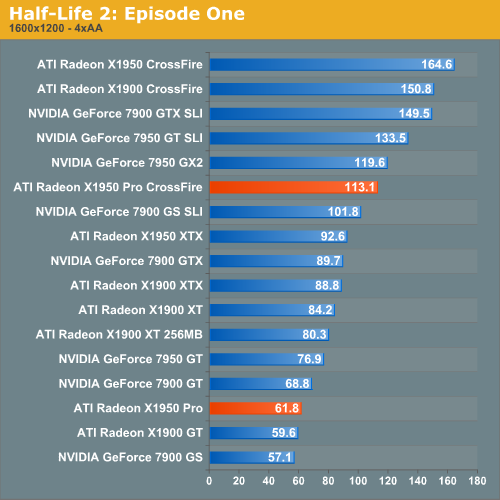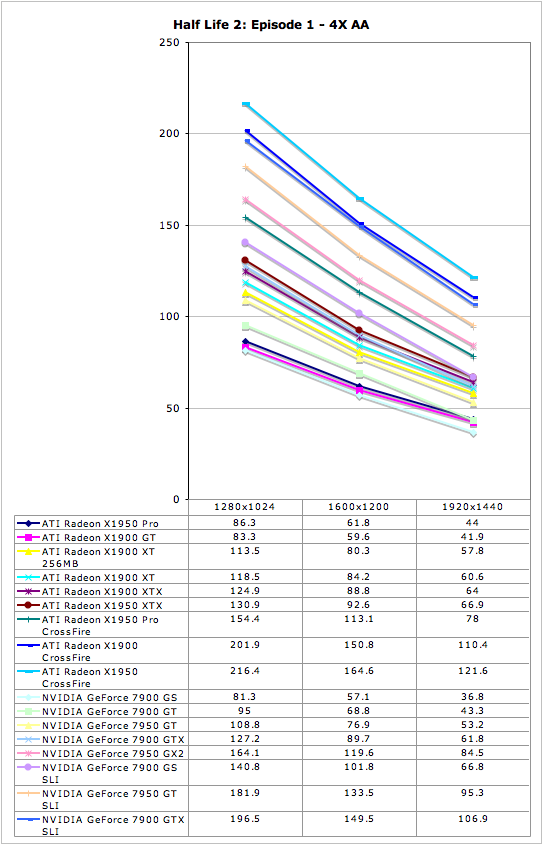ATI Radeon X1950 Pro: CrossFire Done Right
by Derek Wilson on October 17, 2006 6:22 AM EST- Posted in
- GPUs
Half-Life 2: Episode One Performance
Episode One of the new Half-Life 2 series makes use of recent Source engine
updates to include Valve's HDR technology. While some people have done HDR
that won't allow antialiasing (even on ATI cards), Valve put a high value on
building an HDR implementation that everyone can use with whatever settings
they want. Consistency of experience is usually not important enough to
developers who care about pushing the bleeding edge of technology, so we are
very happy to see Valve going down this path.
We use the built-in timedemo feature to benchmark the game. Our timedemo
consists of a protracted rocket launcher fight and features much debris and
pyrotechnics. The Source engine timedemo feature is more like the nettimedemo
of Id's Doom 3 engine, in that it plays back more than just the graphics. In
fact, Valve includes some fairly intensive diagnostic tools that will reveal
almost everything about every object in a scene. We haven't found a good use
for this in the context of reviewing computer hardware, but our options are
always open.
The highest visual quality settings possible were used including the "reflect
all" setting which is normally not enabled by default, and anisotropic
filtering was set at 8x. While the Source engine is notorious for giving great
framerates for almost any hardware setup, we find the game isn't as enjoyable
if it isn't running at at least 30fps. This is very attainable even at the
highest resolution we tested on most cards, and thus our target framerate is a
little higher in this game than others.

Showing about a 10% performance advantage over the 7900 GS, the X1950 Pro delivers a good level of performance under Half-Life 2: Episode One without AA enabled. Combine that with the fact that CrossFire delivers about an 80% performance improvement to SLI's 66%, and we have a clear winner in the mulit-GPU department here.


Enabling 4xAA under HL2:EP1 closes the gap between ATI and NVIDIA at the $200
mark, but still leaves ATI in the lead. The same is true in the multi-GPU
arena.











45 Comments
View All Comments
Spoelie - Tuesday, October 17, 2006 - link
Bit disappointed, was hoping for 600/700 clocks. I'm curious about the temperatures under load and if it would easily overclock to at least those speeds. And what about HDCP? But I guess we'll have to wait for retail cards.If the price is €200 or less I just might be getting one to replace my x800xt :)
Spoelie - Tuesday, October 17, 2006 - link
Apparantly, powercolor clocks all its x1950pro cards up to 600/700 and have a 512mb sku. Plus silent cooling :)http://www.powercolor.com/global/main_product_seri...">http://www.powercolor.com/global/main_product_seri...
No word on hdcp and price tho :/
DerekWilson - Tuesday, October 17, 2006 - link
HDCP support is optional for vendors, but it seems like ATI is heavily encouraging them to include HDCP on all 1950 PRO cards. Since it's not guaranteed, be sure to check the specifications before you purchase.The power color 1950 PRO is not passively cooled but it includes a low dB fan. It does look like an interesting product, and we intend to acquire one for further investigation.
Goty - Tuesday, October 17, 2006 - link
Go read the review over at bit-tech. They've got prices up and the Saphire card they reviewed has HDCP.MadBadger - Tuesday, October 17, 2006 - link
Thanks for the review :beer;An observation:
-the pricefinder at the top of the article seems a bit out of whack. It shows as x1950 512 mb (PCI), but it links to the 1950 pro 256 mb for amazon and to the x1950 xt for the others.